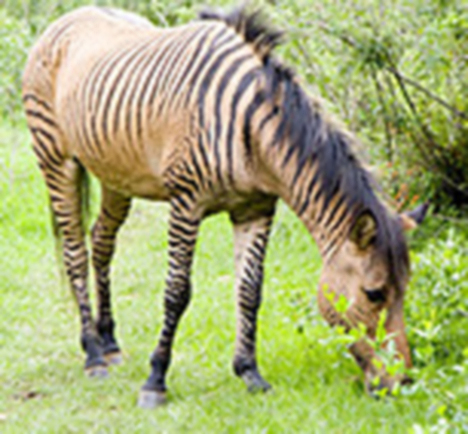
A zorse or zebrula is a zebroid, specifically the offspring of a zebra stallion and a horse mare. The rarer reverse pairing is sometimes called a horbra. Like most other hybrids, the zorse is infertile. The zorse is a strong animal with traces from both its parents. James Cossar Ewart crossed a zebra stallion with horse and pony mares in order to investigate the theory of telegony, or paternal impression. Cossar Ewart used Arabian mares. Similar experiments were carried out by the US Government and reported in "Genetics in Relation to Agriculture" by E.B. Babcock and R.E. Clausen, and in "The Science of Life" by H.G. Wells, J. Huxley and G.P. Wells (c.1929). Zorses are bred in Africa and used for trekking on Mount Kenya.
Coloration

Zorses combine the zebra striping overlaid on colored areas of the hybrid's coat. Zorses are most often bred using solid color horses. If the horse parent is piebald (black and white) or skewbald (other color and white) (these are known in the USA as paint/pinto) the zorse may inherit the dominant de-pigmentation genes for white patches, it is understood that Tobiano (the most common white modifier found in the horse) directly interacts with the Zorse coat to give the white markings. Only the non-depigmented areas will have Zebra striping, resulting in a zorse with white patches and striped patches. This effect is seen in the zebroid Eclyse (a hebra rather than a zorse) born in Stukenbrock, Germany in 2007 to a zebra mare called Eclipse and a stallion called Ulysses.
Zorses and humans

"It soon became apparent that zorses are not the easiest of the equine family to get along with." -- Trainer Pat Parelli, on working with zorses. Zorses are preferred over zebras for riding and draught for several reasons, although they are still not as easily handled as horses and should not be ridden or purchased by novices. Their more horselike shape, particularly in the shoulder region, makes it easier to obtain harness that fits correctly. Zebras, being wild animals, and not domesticated like horses and donkeys, pass on their wild animal traits to their offspring. Zebras, while not usually very large, are extremely strong and aggressive. Similarly, zorses have a strong temperament and can be aggressive.
Notable zorses
- A zorse (more accurately a zony) was born at Eden Ostrich World, Cumbria, England in 2001 after a zebra was left in a field with a Shetland pony. It was referred to as a Zetland. This was the inspiration for the 2003 'Song For the Zorse' by London band The Coronets.
- According to local lore brown zorses have been spotted in the foot hills of the Appalachians in and around Charlottesville, Virginia.
- In the Viva La Bam episode Groundhogs Day in the final race, Brandon Dicamillo's sled is a Zorse. It was colored pink, blue, purple and red and on the 'uncommentary' on the DVD seasons of 'Viva La Bam' Tim Glomb says "If you send me a list of all the episodes where the Zorse is I'll give you a dollar".
- The 2007 movie I'm Reed Fish features a zorse named Zabrina.
- An animated zorse appears in the alternate ending of the movie Racing Stripes. It is the son of Stripes (a zebra) and Sandy, a white filly.
- Zorses are briefly mentioned several times in George R.R. Martin's A Song of Ice and Fire series of fantasy novels.
- Sutton Coleman wrote a sonnet about Zorses and published it in his 2007 book, "Ligers, Tigons, and Zorses, Oh My!"
References
- BBC News (26 June, 2001): "Zebra Hybrid is Cute Surprise"
- Metro (28 June, 2007): "A single-zorsed story"
External links
- The International Zebra Zorse Zonkey Association
- Zorseman.com
- Zebra/Horse Hybrids
- Video of a Zorse
- Newsvideo of a Zorse (German)









